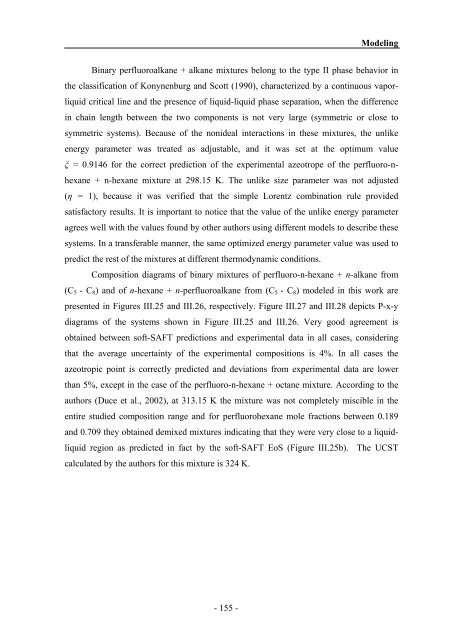n - PATh :.: Process and Product Applied Thermodynamics research ...
n - PATh :.: Process and Product Applied Thermodynamics research ...
n - PATh :.: Process and Product Applied Thermodynamics research ...
You also want an ePaper? Increase the reach of your titles
YUMPU automatically turns print PDFs into web optimized ePapers that Google loves.
Modeling<br />
Binary perfluoroalkane + alkane mixtures belong to the type II phase behavior in<br />
the classification of Konynenburg <strong>and</strong> Scott (1990), characterized by a continuous vapor-<br />
liquid critical line <strong>and</strong> the presence of liquid-liquid phase separation, when the difference<br />
in chain length between the two components is not very large (symmetric or close to<br />
symmetric systems). Because of the nonideal interactions in these mixtures, the unlike<br />
energy parameter was treated as adjustable, <strong>and</strong> it was set at the optimum value<br />
ξ = 0.9146 for the correct prediction of the experimental azeotrope of the perfluoro-n-<br />
hexane + n-hexane mixture at 298.15 K. The unlike size parameter was not adjusted<br />
(η = 1), because it was verified that the simple Lorentz combination rule provided<br />
satisfactory results. It is important to notice that the value of the unlike energy parameter<br />
agrees well with the values found by other authors using different models to describe these<br />
systems. In a transferable manner, the same optimized energy parameter value was used to<br />
predict the rest of the mixtures at different thermodynamic conditions.<br />
Composition diagrams of binary mixtures of perfluoro-n-hexane + n-alkane from<br />
(C5 - C8) <strong>and</strong> of n-hexane + n-perfluoroalkane from (C5 - C8) modeled in this work are<br />
presented in Figures III.25 <strong>and</strong> III.26, respectively. Figure III.27 <strong>and</strong> III.28 depicts P-x-y<br />
diagrams of the systems shown in Figure III.25 <strong>and</strong> III.26. Very good agreement is<br />
obtained between soft-SAFT predictions <strong>and</strong> experimental data in all cases, considering<br />
that the average uncertainty of the experimental compositions is 4%. In all cases the<br />
azeotropic point is correctly predicted <strong>and</strong> deviations from experimental data are lower<br />
than 5%, except in the case of the perfluoro-n-hexane + octane mixture. According to the<br />
authors (Duce et al., 2002), at 313.15 K the mixture was not completely miscible in the<br />
entire studied composition range <strong>and</strong> for perfluorohexane mole fractions between 0.189<br />
<strong>and</strong> 0.709 they obtained demixed mixtures indicating that they were very close to a liquidliquid<br />
region as predicted in fact by the soft-SAFT EoS (Figure III.25b). The UCST<br />
calculated by the authors for this mixture is 324 K.<br />
- 155 -



